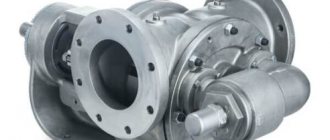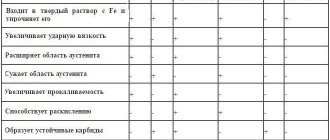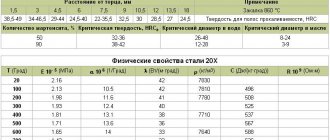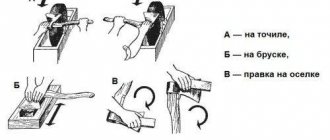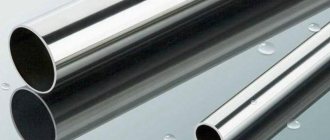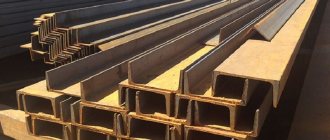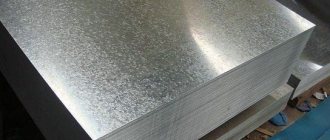Chemical composition of steel 08x18n10t
Titanium (up to 0.7%) is added to the stainless steel alloy 08x18n10t as an additional alloying component, which gives additional mechanical hardness to this grade of steel. GOST 5632-72 also allows the presence of molybdenum and up to 0.4% copper in the composition in small (up to 0.1 - 0.3%) quantities.
Table of chemical properties of steel 08x18n10t
Mechanical characteristics
| Section, mm | sТ|s0.2, MPa | σB, MPa | d5, % | d4 | d10 | y, % | kJ/m2, kJ/m2 | Brinell hardness, MPa |
| Small-sized tubes (capillary) heat-treated or cold-worked as delivered according to GOST 14162-79 | ||||||||
| — | ≥529 | ≥37 | — | — | — | — | — | |
| Long products | ||||||||
| — | ≥275 | ≥610 | ≥41 | — | — | ≥63 | ≥245 | — |
| — | ≥200 | ≥450 | ≥31 | — | — | ≥65 | — | — |
| — | ≥175 | ≥440 | ≥31 | — | — | ≥65 | ≥313 | — |
| — | ≥175 | ≥440 | ≥29 | — | — | ≥65 | ≥363 | — |
| — | ≥175 | ≥390 | ≥25 | — | — | ≥61 | ≥353 | — |
| — | ≥160 | ≥270 | ≥26 | — | — | ≥59 | ≥333 | — |
| Seamless pipes for oil and fuel lines, heat-treated as delivered according to GOST 19277-73 | ||||||||
| — | ≥549 | ≥40 | — | — | — | — | — | |
| Blanks (forgings and stampings) according to OST 95-29-72 in delivery condition: Austenization at 1020-1100 °C, cooling in water or air | ||||||||
| ≥226 | ≥490 | ≥37 | — | — | — | — | — | |
| Forgings without machining in delivery condition according to TU 108.11.894-87. Longitudinal samples | ||||||||
| 20 | ≥196 | ≥490 | ≥38 | — | — | ≥45 | — | — |
| Blanks (forgings and stampings) according to OST 95-29-72 in delivery condition: Austenization at 1020-1100 °C, cooling in water or air | ||||||||
| ≥176 | ≥352 | — | — | — | — | — | — | |
| Forgings without machining in delivery condition according to TU 108.11.894-87. Longitudinal samples | ||||||||
| 350 | ≥137 | ≥314 | ≥25 | — | — | ≥40 | — | — |
| Blanks for pipeline fittings made of steel 08Х18Н10Т according to ST TsKBA 016-2005. Hardening in water or in air from 1020-1100 °C (holding time 1.0-1.5 min/mm of largest cross-section but not less than 0.5 h) | ||||||||
| ≤60 | ≥196 | ≥490 | ≥40 | — | — | ≥55 | — | 121-179 |
| Rods according to TU 14-1-2787-2004. Longitudinal samples. Quenching in water or air from 1050-1080 °C | ||||||||
| ≥205 | ≥490 | ≥40 | — | — | ≥55 | — | — | |
| Blanks for pipeline fittings made of steel 08Х18Н10Т according to ST TsKBA 016-2005. Hardening in water or in air from 1020-1100 °C (holding time 1.0-1.5 min/mm of largest cross-section but not less than 0.5 h) | ||||||||
| 60-100 | ≥196 | ≥490 | ≥39 | — | — | ≥50 | — | 121-179 |
| Rods according to TU 14-1-2787-2004. Longitudinal samples. Quenching in water or air from 1050-1080 °C | ||||||||
| ≥177 | ≥350 | ≥30 | — | — | ≥40 | — | — | |
| Blanks for pipeline fittings made of steel 08Х18Н10Т according to ST TsKBA 016-2005. Hardening in water or in air from 1020-1100 °C (holding time 1.0-1.5 min/mm of largest cross-section but not less than 0.5 h) | ||||||||
| 100-200 | ≥196 | ≥490 | ≥38 | — | — | ≥40 | — | 121-179 |
| Pipe blank according to TU 14-1-686-88. Quenching in water or air from 1050-1080 °C | ||||||||
| — | ≥205 | ≥490 | ≥40 | — | — | — | — | — |
| Blanks for pipeline fittings made of steel 08Х18Н10Т according to ST TsKBA 016-2005. Hardening in water or in air from 1020-1100 °C (holding time 1.0-1.5 min/mm of largest cross-section but not less than 0.5 h) | ||||||||
| 200 | ≥196 | ≥490 | ≥35 | — | — | ≥40 | — | 121-179 |
| Pipe blank according to TU 14-1-686-88. Quenching in water or air from 1050-1080 °C | ||||||||
| — | ≥176 | ≥353 | ≥30 | — | — | — | — | — |
| Blanks for pipeline fittings made of steel 08Х18Н10Т-ВД, 08Х18Н10Т-Ш according to ST TsKBA 016-2005. Hardening in water or in air from 1040-1060 °C (holding time 1.0-1.5 min/mm of largest cross-section but not less than 0.5 h) | ||||||||
| ≤250 | ≥260 | ≥490 | ≥40 | — | — | ≥55 | — | 121-179 |
| Seamless pipes for power engineering in accordance with GOST 24030-80 (samples, the outer diameter of the pipes is indicated in the cross-section) | ||||||||
| 76 | 176-333 | — | — | — | — | — | — | — |
| Cold rolled strip 0.05-2.00 mm according to GOST 4986-79. Quenching in water or air from 1050-1080 °C (samples) | ||||||||
| 0.2-2 | — | ≥530 | — | ≥40 | — | — | — | — |
| Seamless pipes for power engineering in accordance with GOST 24030-80 (samples, the outer diameter of the pipes is indicated in the cross-section) | ||||||||
| ≤76 | 176-343 | — | — | — | — | — | — | — |
| Cold rolled strip 0.05-2.00 mm according to GOST 4986-79. Quenching in water or air from 1050-1080 °C (samples) | ||||||||
| 0.2 | — | ≥530 | — | ≥20 | — | — | — | — |
| Seamless pipes for power engineering in accordance with GOST 24030-80 (samples, the outer diameter of the pipes is indicated in the cross-section) | ||||||||
| — | ≥549 | ≥37 | — | — | — | — | — | |
| Cold rolled steel sheets in delivery condition according to TU 14-1-3874-84 | ||||||||
| 0.5-1 | ≤285 | 510-640 | — | ≥50 | — | — | — | — |
| Seamless pipes for power engineering in accordance with GOST 24030-80 (samples, the outer diameter of the pipes is indicated in the cross-section) | ||||||||
| ≤76 | 176-323 | — | — | — | — | — | — | — |
| ≤76 | ≥147 | — | — | — | — | — | — | — |
| Hot rolled sheets (1.5-3.9 mm) and cold rolled sheets (0.7-3.9 mm) according to GOST 5582-75. Hardening in water or air from 1050-1080 °C | ||||||||
| — | — | ≥530 | ≥40 | — | — | — | — | — |
| Seamless pipes. Heating up to 950-1050 °C, rapid cooling in air or water (the wall thickness is indicated in the cross-section) | ||||||||
| ≤15 | ≥216 | ≥549 | ≥37 | — | — | ≥55 | — | — |
| Hot rolled sheets (4.0-50.0 mm) and cold rolled sheets (4.0-5.0 mm) according to GOST 7350-77. Hardening in water or air from 1000-1080 °C | ||||||||
| — | ≥205 | ≥510 | ≥43 | — | — | — | — | — |
| Forgings for parts resistant to MCC. Quenching from 1000-1050 °C in oil, water or air | ||||||||
| 100-300 | 196-210 | ≥490 | ≥38 | — | — | ≥45 | — | 121-179 |
| Seamless pipes. Heating up to 950-1050 °C, rapid cooling in air or water (the wall thickness is indicated in the cross-section) | ||||||||
| 15 | ≥216 | ≥510 | ≥37 | — | — | ≥55 | — | — |
| Forgings for parts resistant to MCC. Quenching from 1000-1050 °C in oil, water or air | ||||||||
| 60-100 | 196-210 | ≥490 | ≥39 | — | — | ≥50 | — | 121-179 |
| Seamless pipes. Heating up to 950-1050 °C, rapid cooling in air or water (the wall thickness is indicated in the cross-section) | ||||||||
| ≥176 | ≥372 | ≥35 | — | — | ≥45 | — | — | |
| Forgings for parts resistant to MCC. Quenching from 1000-1050 °C in oil, water or air | ||||||||
| 60 | 196-210 | ≥490 | ≥40 | — | — | ≥55 | — | 121-179 |
| Forgings. Quenching in air, oil or water from 1050-1100 °C | ||||||||
| ≥196 | ≥490 | ≥35 | — | — | ≥40 | — | — | |
| Cold-rolled thin-sheet and heat-treated bent profiles in delivery condition in accordance with GOST R 51393-99. Hardening in water or air from 1050-1080 °C | ||||||||
| — | ≥205 | ≥520 | ≥40 | — | — | — | — | — |
| Bars calibrated as delivered (work-hardened) according to TU 14-1-3581-83 | ||||||||
| 20-25 | ≥225 | ≥539 | ≥25 | — | — | ≥55 | — | — |
| Ground rods, processed to a specified strength (TS) according to GOST 18907-73 | ||||||||
| 1-30 | — | 590-830 | — | — | ≥20 | — | — | — |
| Sections in delivery condition (longitudinal samples) | ||||||||
| ≤8 | — | 1400-1600 | ≥20 | — | — | — | — | — |
| 3.5-32 | — | ≥510 | ≥40 | — | — | — | — | — |
| Hot-rolled and forged long products according to GOST 5949-75. Quenching in air, oil or water from 1020-1100 °C | ||||||||
| ≥196 | ≥490 | ≥40 | — | — | ≥55 | — | — | |
| Hot-rolled and forged long products according to STP 26.260.484-2004. Hardening in water or in air from 1050-1150 °C | ||||||||
| ≥200 | ≥500 | ≥40 | — | — | ≥55 | — | — | |
| Hot-rolled and forged long products according to STP 26.260.484-2004. Stabilizing annealing at 870-900 °C, cooling in air or Stepwise processing according to the mode: heating to 1050-1100 °C; holding time when heating for products with a wall thickness of up to 10 mm - 30 minutes, over 10 mm - 20 minutes + 1 minute per 1 mm of maximum thickness; cooling at the highest possible speed up to 870-900°C; exposure at 870-900 °C for 2-3 hours; cooling with a furnace to 300 °C (speed - 50-100 °C/h), then in air | ||||||||
| ≥200 | ≥500 | ≥35 | — | — | ≥50 | — | — | |
| Heat-treated thin sheet metal (softening) according to TU 14-1-3199-81 | ||||||||
| 0.5-3 | ≥274.4 | ≥529.2 | ≥40 | — | — | — | — | — |
| Heat-treated pipe blank according to TU 14-1-3844-84. Longitudinal and tangential samples | ||||||||
| — | ≥510 | ≥40 | — | — | — | — | — | |
| Risk-free cold-deformed seamless pipes (cold-rolled, cold-drawn and warm-rolled) according to TU 14-3-769-78. Heat treated, as delivered | ||||||||
| ≥196 | ≥529 | ≥35 | — | — | — | — | — | |
| Seamless hot-deformed pipes as delivered in accordance with GOST 9940-81 | ||||||||
| — | ≥510 | ≥40 | — | — | — | — | — | |
| Seamless extra-thin-walled pipes with a diameter of up to 60 mm in a cold-worked state according to TU 14-3-770-78 | ||||||||
| ≥196 | ≥530 | ≥37 | — | — | — | — | — | |
| Seamless cold- and heat-deformed pipes of improved quality in delivery condition according to TU 14-3-1109-82 | ||||||||
| — | ≥558 | ≥38 | — | — | — | — | — | |
| Extra-thin-walled cold- and heat-deformed pipes (wall thickness 0.2-1.0 mm) as delivered | ||||||||
| — | ≥549 | — | ≥40 | — | — | — | — | |
| Hexagonal heat-treated press-product pipes according to TU 14-131-880-97 | ||||||||
| ≥196 | ≥490 | ≥40 | — | — | ≥55 | — | — | |
| Heat-treated centrifugal cast pipes in the delivery condition according to TU 14-3R-115-2010. Quenching in water or in air under a fan at 1050-1080 °C | ||||||||
| ≥180 | ≥460 | ≥35 | — | — | — | — | — | |
| Heat-treated electric-welded pipes, as delivered (Dн=8.0-102.0 mm) | ||||||||
| ≥216 | ≥530 | ≥37 | — | — | — | — | — | |
Physical properties of steel 08x18n10t
Stainless steel 08x18n10t has good weldability. Recommended welding methods are manual arc welding, argon-arc welding in a protective gas environment with a tungsten electrode, spot welding, ESW.
In an unhardened state, this grade of steel is prone to intergranular corrosion. The recommended maximum temperature at which it is possible to operate steel 08x18n10t without changing the mechanical properties is 800°C.
Steel 08x18n10t is well polished, including to a mirror finish.
Table of basic physical properties 08x18n10t
List of similar brands
The characteristics of steel 08Х18Н10Т are identical to those of some foreign brands of stainless steel. These include:
- AISI 321, S32100 – America;
- 1.4541, 1.4878, X10CrNiTi18-9, X6CrNiTi18-10 – Germany;
- SUS321 – Japan;
- 321F00, Z6CN18-10, Z6CNT18-10 – France;
- 321S12, 321S18, 321S20, 321S22, 321S31 – England;
- 1.4541, X10CrNiTi18-10, X6CrNiTi18-10 – Europe;
- X6CrNiTi18-11, X8CrNiTi1811 – Italy;
- F3523, X6CrNiTi18-10 – Spain;
- 0Cr18Ni11Ti, 1Cr18Ni9Ti, OCr18Ni10Ti – China;
- 2337 – Sweden;
- 0H18N10T, 1H18N10T, 1H18N9T – Poland;
- 17246, 17247, 17248 – Czech Republic;
- X6CrNiTi18-10S, X6CrNiTi1810K-KW – Austria
Among the alloys produced in Russia, one can note 10Х17Н13М2Т and 10Х17Н13М2 (do not contain titanium), as well as 10Х17Н13МЗТ, which contains a high content of molybdenum.
A cheaper analogue, 12X17, is also produced in Russia. It has anti-corrosion properties. But its use is impossible at extremely high temperatures. In addition, its chemical and physical characteristics remain unchanged only when in slightly aggressive environments.
Foreign analogues of Steel 08Х18Н10Т
| USA | Germany | Japan | France | England | European Union |
| — | DIN,WNr | JIS | AFNOR | B.S. | EN |
| 321 | 1,4541 | SUS321 | 321F00 | 321S12 | 1,4541 |
| S32100 | 1,4878 | Z6CN18-10 | 321S18 | X10CrNiTi18-10 | |
| X10CrNiTi18-9 | Z6CNT18-10 | 321S20 | X6CrNiTi18-10 | ||
| X12CrNiTi18-9 | 321S22 | ||||
| X6CrNiTi18-10 | 321S31 | ||||
| Italy | Spain | China | Poland | Czech | Austria |
| UNI | UNE | G.B. | PN | CSN | ONORM |
| X6CrNiTi18-11 | F.3523 | 0Cr18Ni11Ti | 0H18N10T | 17246 | X6CrNiTi18-10S |
| X8CrNiTi1811 | X6CrNiTi18-10 | 1Cr18Ni9Ti | 1H18N10T | 17247 | X6CrNiTi1810K-KW |
| OCr18Ni10Ti | 1H18N9T | 17248 |
Legend
| Mechanical properties | |
| σB | temporary tensile strength (tensile strength), MPa |
| σ0.2 | conditional yield strength, MPa |
| σcom | compressive strength, MPa |
| σco0.2 | compressive yield strength, MPa |
| σ0.05 | elastic limit, MPa |
| σben | bending strength, MPa |
| σ-1 | endurance limit during bending test with a symmetrical loading cycle, MPa |
| δ5, δ4, δ10 | relative elongation after rupture, % |
| ψ | relative narrowing, % |
| ν | relative shift, % |
| ε | relative settlement at the appearance of the first crack, % |
| τK | ultimate torsional strength, maximum shear stress, MPa |
| τ-1 | endurance limit during torsion testing with a symmetrical loading cycle, MPa |
| KCU and KCV | impact strength, determined on a sample with concentrators of the U and V types, J/cm2 |
| HRСе and HRB | Rockwell hardness (scale C and B respectively) |
| HB | Brinell hardness |
| H.V. | Vickers hardness |
| HSD | Shore hardness |
| Physical properties | |
| E | normal modulus of elasticity, GPa |
| G | modulus of elasticity in torsional shear, GPa |
| ρn | density, kg/m3 |
| λ | thermal conductivity coefficient, W/(m∙°C) |
| ρ | electrical resistivity, Ohm∙m |
| α | linear thermal expansion coefficient, 10-61/°С |
| With | specific heat capacity, J/(kg∙°С) |
Sources
- https://InstrumentBaza.ru/materialy/08h18n10t-harakteristiki.html
- https://paes250.ru/vidy-stali/plotnost-08h18n10t.html
- https://pressadv.ru/stali/08h18n10t-harakteristiki.html
- https://iopent.ru/pro-materialy/plotnost-08h18n10t.html
- https://intehstroy-spb.ru/spravochnik/nerzhaveyuschaya-stal-marki-08h18n10t.html
- https://ipmet.ru/nerzhaveyushhaya-stal-08x-18n-10t-xarakteristiki-priminenie-analogi/
- https://uraltm08.ru/stati/kak-rasshifrovat-marku-stali.html
- https://svarkaipayka.ru/material/stal/tehnicheskie-harakteristiki-stali-08h18n10t.html
- https://vse-stali.ru/stali-i-splavy-korrozionnostojkie-zharoprochnye-zharostojkie-iznosostojkie/stal-08h18n10t/
Application of stainless steel 08x18n10t
Stainless steel 08x18n10t, or as it is often called “technical stainless steel”, is used in many areas of production:
- Production of thin sheet metal and seamless stainless steel pipes
- Manufacturing of welding equipment, welding electrodes, spark plugs.
- Production of equipment and parts operating in highly aggressive environments, including welded structures.
- Chemical industry: for the manufacture of containers and pipelines (pipes and pipeline fittings) in contact with acidic and alkaline environments, including aggressive saline solutions.
- Production of equipment operating in the range of medium (up to 800°C) temperatures: furnace fittings, heat exchangers, casings and parts of thermal and steam boilers.
- Oil and gas industry: for the production of reservoirs and tanks intended for storing substances (compressed and liquefied gases) under pressure.
- Polished types of steel of this grade can be used as a decorative material.
Rating: 9.00/10 — 21 votes
Russian steel marking system
There is no unified steel marking system on the global metals market. In parallel, there are Russian, European, American and Japanese systems. The lack of a uniform standard introduces certain difficulties in international trade transactions.
Our country has adopted an alphanumeric system. In it, letters correspond to various elements, and numbers indicate the content of the corresponding elements. Germany also sometimes uses a system similar in principle to the Russian one.
The alphanumeric system has a huge advantage over others, since it allows not only to distinguish one grade of steel from another, but also to judge technological and structural characteristics by a set of letters and numbers.
Some special designations are also used in the domestic system:
- Ordinary quality steels are designated by the index “St”, followed by the grade number. A group of guaranteed properties (mechanical, chemical composition) may be indicated in front of it.
- Structural high-quality carbon steels are designated by hundredths of the percentage of carbon and marked by the degree of deoxidation (for example, 08KP).
- High-quality carbon tool steels are designated by the index “U”, followed by the carbon content in tenths of a percent (for example, U8).
- High-speed steels are designated by the index “P”, followed by the tungsten content as a percentage (for example, P18).
The marking of alloy steels is very informative: the corresponding letters of the Russian alphabet are used to designate alloying elements: “X” - chromium, “N” - nickel, “T” - titanium, “M” - molybdenum, “Yu” - aluminum, “B” - tungsten, etc.
When marking structural alloy steels, the carbon content is indicated at the very beginning in hundredths of a percent, and when marking tool alloy steels, in tenths of a percent.
History of discovery
Today it is difficult to imagine a world without numerous inventions.
Many of them were made by accident. This is how stainless steel appeared. The first historical mention of this metal can be found in the records of Harry Brierley. This metallurgist researcher in 1912 took an order from one of the weapons companies to find an effective way to extend the service life of gun barrels. The practitioner began to work in his usual style - he began mixing different components. The man tested the finished alloys for heat resistance and durability. If the indicators were low, the blanks were sent to a landfill. One of the details stood out among all with its brilliance. After a detailed study of the analysis, scientists found that the alloy consists of several elements:
- iron - 85.3%;
- chromium - 12.8%;
- manganese - 0.44%;
- carbon - 0.24%;
- silicon - 0.2%.
Not all researchers give the lead in the discovery of the stainless flock to Harry Brierley. Some believe that stainless steel was discovered by Pierre Berthier, a French mining engineer. He discovered that certain compounds of iron and chromium, which can be found in nature, stand out for their high acid resistance. He was the first to suggest making dishes and cutlery from them.
Analogs
In the standards of other countries, this brand may have the following markings:
- America – AISI 304; 321;
- Japan - SUS321;
- Germany - 1.4541;
- China - 2337.
The Russian analogues are two types of alloys:
- with the addition of molybdenum - 10Х17Н13М2Т, 10Х17Н13М2 (without titanium); 10Х17Н13М3Т (with an increase in molybdenum to 3%);
- without Ti - 08Х18Н9 or with nickel content up to 10;
- a cheaper analogue that is corrosion resistant at normal temperatures and slightly aggressive environments is 12X17.


